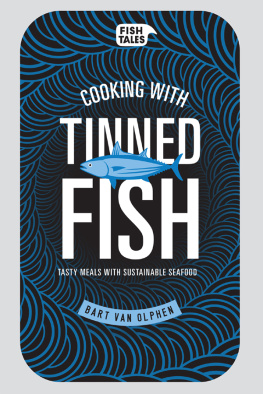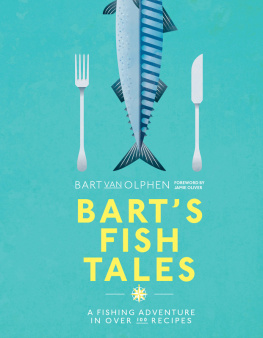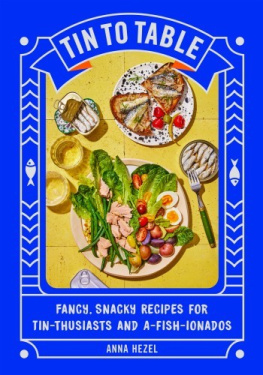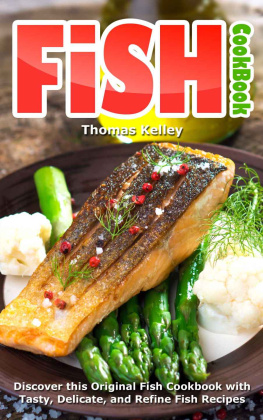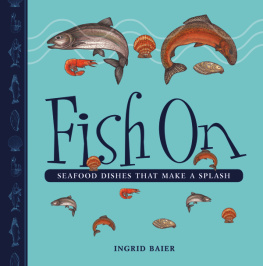



CONTENTS

INTRODUCTION
TRAVELLING to fishing communities all over the world inspired me to give the fishermen and their wonderful stories their place on the cookbook shelves. Their sustainably caught fish is the foundation of the recipes in this book. By supporting sustainable fish, we give endangered fish populations the opportunity to recover. So lets get to work with sustainable fish: the fisherman with his nets and rods, the cook with pots and pans.
TO make sure the fish lover is able to enjoy both preserved and fresh fish in the future, many fisheries will have to start operating differently from how they are now. And by buying only sustainable and fresh fish, the consumer can make an important contribution to that endeavour.
IF theres one thing Ive learned during my travels, its the fact we can make a big impact on sustainability by making ethical choices over tinned fish. After all, a lot of wild fish ends up in a tin. These fish are accessible and affordable to many, even if youre on a budget, and with tinned fish you can easily prepare tasty and nutritious meals.
WE often dont know where fish comes from and how it was caught. The lack of good information prevents consumers from making the right choices to suit their lifestyle. Because they have labels, it is easy for the manufacturer to inform the consumer about what fish are in the tin, how they were caught and what happened to them between the sea and the tin. Transparency makes all the difference. You need to know the stories behind the product in order to love the product. Thats why in this book you wont just find unexpected recipes, youll also get to know the fishermen and manufacturers. They made the conscious decision to fish with the environment in mind or use sustainable fish in their produce. By opting for sustainable produce, the consumer can in turn influence fishing methods and fish populations.
MORE and more tinned fish manufacturers are taking responsibility by adding certification labels from organisations such as the MSC, the Marine Stewardship Council. The MSC continually verify fisheries compliance with protocols; for example, minimising the bycatch of dolphins caught in tuna nets. The certification label assures the consumer that the fish theyve bought has come from fisheries operating under sustainable fishing guidelines.
IN addition to the fishing method, flavour is of course very important in the produce. Mass production and anonymity often impact negatively on flavour and quality. Ive found that doesnt have to be the case. Thats why I founded Fish Tales, offering the tastiest tinned fish, smoked or fresh, caught by environmentally responsible fishermen. They view the seas and oceans as the source of all life. Their fish has no artificial flavour. Try it, taste the difference and judge for yourself.
TINNED fish is surprisingly versatile in the kitchen. We took the task of creating sumptuous dishes with tinned fish as a challenge. The results may surprise you. We selected 50 of the best recipes from an impressive collection. This book offers you the best of both worlds: fresh produce combined with tinned tuna, salmon, crab, cockles, mackerel, mussels, anchovies and sardines.
BART VAN OLPHEN, AUGUST 2014


LOOKING BACK
THE life of our tinned fish starts, oddly enough, with glass. At the end of the eighteenth century the industrial revolution led to a sharp rise in the population of the industrialised nations; and more people called for more food. Fridges hadnt been invented yet and transportation of fresh produce was slow. Preserving methods such as drying, smoking, pickling, curing and conserving in fat or sugar offered little relief and were too expensive on a large scale. Cheaply and safely preserved food was supposed to be the solution for the growing need for food. Even Napoleon Bonaparte faced the troubles of perishable foods, which threatened his ambitions. Hungry soldiers are hardly the ideal force to help you win battles, and in 1795 the French government offered a money prize to whoever could make preserved, nutritious food for a soldiers ration.
AT the time, French confectioner Nicolas Appert was experimenting with food. Appert had years of experience in the techniques of making syrups and confectionery, and he began heating jars of food in water up to 100C/200F, then cooling them down. Once he had perfected the technique, he achieved the desired outcome: he was able to successfully preserve meat, vegetables and fruit by the technique now known as sterilisation. Although preserving fruit by heating it is a technique that had been around long before Appert, he was the first to research the effects of airtight seals and applying high temperatures to food. Appert eventually supplied the navy, which intended to use his preserved fruit to prevent their crew from contracting scurvy. When his efforts proved successful, the navy informed the French government who awarded Appert the prize money in 1810. Apperts jars enabled the troops to charge into battle well fed, and his conserving method survived Napoleon Bonaparte. The confectioner could easily be seen as a food scientist avant la lettre and the founder of convenience food. Louis Pasteur would later improve on Apperts technique, turning down the heat by about thirty degrees. Pasteurisation killed enough harmful bacteria and retained more flavour.
THE French government insisted Nicolas Appert should publish his research. LArt de conserver, pendant plusieurs annes, toutes les substances animals et vgtables is probably one of the first books on preserving food that found its way into many households around the world. In Britain, the book found its way to Pierre Durand, a Frenchman who anglicised his name to Peter Durand. He held a patent for conserving food in glass and tin cans. Appert nudged Durand in the right direction, but Durand didnt pursue the business further and sold his patent cheaply to Donkin, Hall and Gamble. Bryan Donkin recognised the potential of conserving food in tin cans. Tins were lighter than glass, didnt break and were easier to manufacture. Again the navy, this time the Britsh navy, served as the testing ground. The rest is history: the British tin came, saw and conquered. The French have one more addition to the history of tinned food. Grimod de la Reynire, a friend of Nicolas Appert, wrote about the sardines of Nantes conserved in butter, oil and vinegar, before Donkin went full steam ahead with his tins. The efforts of Nicolas Appert and later Louis Pasteur form the basis of the food industry as we now know it. Even now the availability of affordable conserved food means not having to go hungry for millions of people around the world.
Next page
